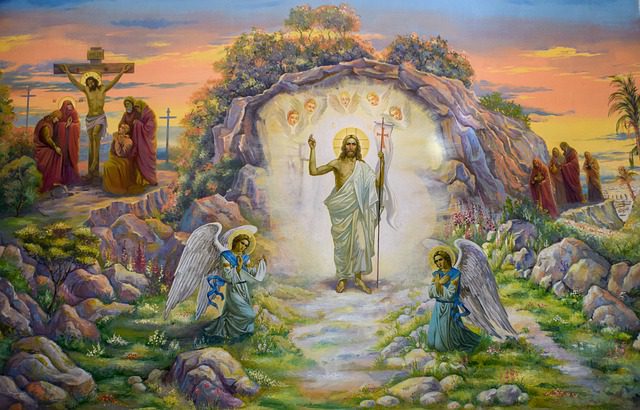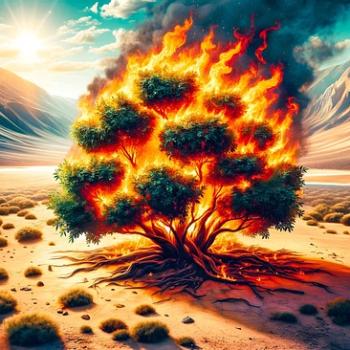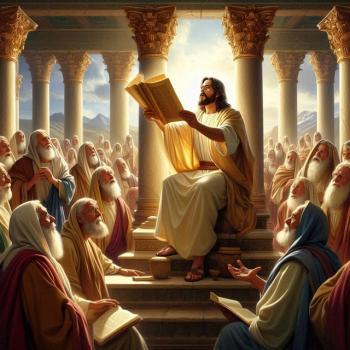
“If then you were raised with Christ, seek what is above, where Christ is seated at the right hand of God.” – Colossians 3:1
At Catholicism’s theological core are two rather remarkable “risings” and two corresponding feasts. I am speaking, of course, of Christ’s rising from the dead, more popularly known as Easter, and of His Ascension to Heaven. These two events have great significance for the Catholic faith.
In the following exposition, I will discuss both Easter and the Ascension of the Lord. I will explore the meaning and purposes of each of these events. Finally, I will discuss how these two risings of Christ provide the foundation for the Catholic Church.
On Easter
While rabbits and eggs have come to symbolize Easter, a much better symbol is the sun. The word Easter is derived from an Old English word for East, and, just as the sun rises in the East, bringing with it light, so Easter symbolizes the rising Christ, who is the true light of the world.
While frequently reduced to one Sunday in late March or early April, the Easter season is actually fifty days, concluding with the Ascension of the Lord.
In order to truly grasp the meaning of Easter, it is helpful to place it within the broader context of the Holy Triduum. The Triduum (three days) refers to the three days of Good Friday through and including Easter Sunday. The Holy Triduum is characterized by diametrically opposed (if only emotionally) events. The sorrow and violence of Good Friday, when Jesus pays the ultimate price for the sins of all mankind by being crucified, is followed by the vigil of Holy Saturday when Christ descended into Hell to free the righteous dead. Finally, there is the joy of His Resurrection.
There is, of course, great theological significance to these three days. Due to original sin, human beings were estranged from God. By being crucified, Jesus takes onto Himself the sins of the world. Indeed, the Bible says that He became sin (2 Corinthians 5:21). In becoming sin and paying the price for sin, which is death (Romans 6:23), Jesus reconciled God and man. However, if the story had ended there, with Jesus dead, we are still lost. For this reason, Saint Paul writes, “And if Christ has not been raised, then empty [too] is our preaching; empty, too, your faith.” (1 Corinthians 15:14).
The significance of this “first rising” is at the heart of Catholicism. When Jesus rose again on the third day, it signified that God was satisfied with the sacrificial death of his Son. In his Resurrection, Jesus justified humanity. Saint Paul writes that Jesus “was delivered up for our trespasses and raised for our justification” (Romans 4:25). By defeating death, Christ has given us the hope of eternal life (See “What Does it Mean to be Saved“).
There is no Easter without Good Friday. Said differently, there is no Resurrection if there is no Crucifixion. Similarly, there is no Catholic Church if there is no Ascension.
The Ascension of the Lord
The second “rising” is the Ascension of the Lord. Forty days after the Resurrection from the dead, Jesus ascends body and soul into Heaven. (See Denzinger, Heinrich. Ritus Orientalium, Coptorum, Syrorum Et Armenorum in Administrandis Sacramentis… Edidit Henricus Denzinger… Nabu Press, 2013).
Jesus ascended into Heaven by his own power, as God in divine power and as a man in the power of his transfigured soul, which moves his transfigured body as it will. Concerning the human nature of Christ, one can also say, with the Scriptures, that it was taken up or elevated into Heaven by God (Mark 16:19; Luke 24:51; Acts 1:9).
There are two important points to make about the Ascension. First, within Catholic theology, the Ascension means the final elevation of Christ’s human nature into the condition of divine glory. It is the concluding work of redemption. Christ’s Ascension is the archetype or model of our own ascension into Heaven. It expresses the Catholic belief that in Christ’s human nature, the humanity that we all share has entered into the inner life of God in a new way.
The second point is that the Ascension of Christ is that it is the necessary condition for Pentecost. In Jesus’s own words, “The Advocate, the Holy Spirit that the Father will send in my name—he will teach you everything and remind you of all that [I] told you.” (See John 14:26).
The Two Risings
In many ways, these two “risings” provide the foundation of Catholicism. On Good Friday, Jesus paid the price for our sins. On Easter Sunday, He overcame that price by rising from the dead. Moreover, by being grafted onto Jesus by virtue of our baptism, Catholics share in Jesus’s death and Resurrection. (See Catechism of the Catholic Church, Paragraph 1988).
Forty days after rising from the dead, Jesus rises to Heaven. The Feast of the Ascension of the Lord celebrates the reality of Christ’s returning to the Father. The Ascension is the final act of the paschal mystery, consisting of Jesus’ Passion, Crucifixion, Death, Burial, Descent Among the Dead, and Resurrection.
Along with the Resurrection, the Ascension functions as more evidence supporting Jesus’s claim that he was the Messiah. Finally, the Ascension is a blow to Satan’s power. Through Christ’s death, Resurrection, and Ascension, the devil no longer holds mankind hostage to sin.
Therefore the Ascension accomplishes three things. First, it completes Jesus’s work of atonement; second, it allows the saints to enter Heaven. Finally, the Ascension anticipates the second coming. This means that Jesus has restored humankind’s relationship with God and shown Himself to be our Lord and Savior.
Conclusion
In a sense, the existence of the Catholic faith is predicated upon two “risings”; Jesus rising from the dead, and His rising to Heaven.
On Easter Sunday, Christ overcame the penalty for sin and created a new relationship, a new covenant, with God and man. On rising to Heaven, Jesus not only showed Himself to be the beloved Son of God, but He also made possible the coming of the Holy Spirit. It is the arrival of the Holy Spirit, that is, Pentecost, that marks the birth of the Catholic Church.












